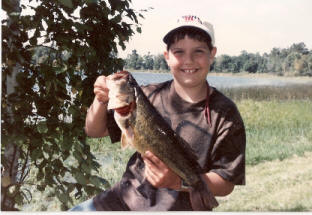Crayfish Crusher

Largemouth bass feed primarily by sight, but in low light or murky water conditions they must rely on their sense of sound and vibration(see lateral line) to detect their prey. Largemouth bass as fingerlings prey on small aquatic insects such as dragonfly nymphs, mosquitoes as they grow up their diets consists of crayfish, frogs, lizards, small birds, and small fish. A sunfish about the size of your hand is about the biggest size sunfish capable of being consumed by a fully grown largemouth bass. Once the prey has been consumed, the complete gut of the largemouth bass will digest the food and absorb the nutrients the bass needs to survive and any excess will be stored as fat for later or waste products will be excreted through the anus. The largemouth bass has a closed circulatory system making transportation of nutrients and oxygen easy. See Internal Anatomy

Environmental Concerns
A rising concern to the amount of mercury in the water which then translates to mercury poisoning in the predator fish such as the largemouth bass and northern pike. The lower level prey organisms are not at a high risk because of the low levels of poison that they take in. The concern comes when the larger fish are consuming all of the lower level fish that each have a little amount of mercury in them. This adds up very quickly especially when the largemouth is one of the top predators. This is getting so much publicity because of the effect this is having on humans. There is now a recommended amount of fish can be consumed in a body of water per day or week.
The Largemouth bass virus is a naturally occurring virus that
infects fish but not warm blooded animals. The virus is
related to a common virus found in frogs and other amphibians.
Transmission of this virus is still unknown and it is only known
to infect the largemouth bass species. Infected bass will
appear to be dizzy or confused. Swimming near the surface
and/or on their side. It appears this virus effects the
swim bladder of the bass. No known strains of
the virus have been successfully transferred to humans.
So far
18 states have reported the virus and Wisconsin is one of the
18.
Appropriate practices should be taken by
anglers to limit the transfer of foreign aquatic plants and
organisms.
Good angling practices include disposing of bait on
land and not in water, do not transfer a fish from one body of
water to another, and cleaning off boats and landing gear. All
of these can help to limit the transfer of this virus. If
you think you have detected a largemouth bass infected with LMBV
contact the local DNR for a course of action. For more information about LMBV check
out
Aquatic Invasive Species.
Check out where the largemouth lives!